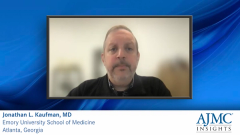
RRMM: An Overview
Joshua Richter, MD, and Jonathan L. Kaufman, MD, define and provide a basic understanding of relapsed/refractory multiple myeloma (RRMM).
Episodes in this series

Joshua Richter, MD: There are specific criteria that we use to define both relapsed, refractory, and relapsed/refractory multiple myeloma. For the most part, they derive from the IMWG, the International Myeloma Working Group. We have 2 sets of criteria; one refers to the numbers, the bad protein that is made by the cancerous cells, and the other refers to symptoms. We call this a biochemical relapse, or symptomatic relapse. Biochemically, we refer to the disease getting worse as being relapsed, and we define relapse as when the M spike increases an absolute amount of 0.5 g/dL, and at least 25% up from baseline. If the patient makes a free light chain only, you take the involved minus the uninvolved light-chain, and that difference has to be increased by more than 100. If you relapse on or within 60 days of your last treatment, we also call that refractory. How can we differentiate? People who get a transplant and no treatment for 2 years, and then their numbers go up, that’s relapsed disease. If you are receiving ongoing therapy and your numbers come up, or your last dose of your therapy was within the last 2 months, you’re both relapsed and refractory to your last line of therapy. We mix this in with symptomatic relapse, which is essentially the development of new CRAB [calcium elevation, renal failure, anemia, bone disease] symptoms. Irrespective of those numbers, if you develop new hypercalcemia, renal failure, anemia, or bone lesions related to your myeloma, that’s a symptomatic relapse of disease that needs to be approached with new line of treatment.
If we look at myeloma broadly, there are around 32,000 to 34,000 new cases per year, and about 10,000 to 12,000 deaths. Unfortunately, everybody ultimately relapses. What this means is that because patients are living longer with our therapies, there is a slow, gradual increase in the number of new diagnoses a year, but the number of deaths is going down. We have more people living with relapsed and refractory disease in the United States. The total number of patients in the United States is probably around 140,000 to 160,000, with many of them being relapsed and refractory. Unfortunately, almost everyone progresses beyond their initial therapy and ends up in that bucket. That number is slowly growing; this is a bigger population of patients that we need to manage. Most of them are in the earlier relapses because the average number of therapy lines that a patient with myeloma gets in the United States is around 3 to 4. Once you get to the fourth line and beyond, it’s fewer than 1% of patients in the United States. Globally, the number of patients with relapsed and refractory myeloma is growing, and it has a lot of impacts—not just in terms of treatment and therapeutic impact but on economic impact as well.
We’ve come a long way in managing disease, with many patients achieving long remissions. However, there are still unmet needs in the myeloma world. One of the big unmet needs is people who progress beyond some of the standard lines of therapy. We have had a lot of FDA approvals, about 12 in the last 10 years with a variety of different therapies. However, we like to think about them in drug classes. Once you progress beyond the IMiDs [immunomodulatory drugs] class, drugs like [lenalidomide] and pomalidomide; the proteasome inhibitor class, drugs like [bortezomib] and carfilzomib; and the monoclonal antibody class drugs like daratumumab, we call that triple-class refractory. Although we do have therapies to address that target, something we call BCMA [B-cell maturation antigen]can do this through CAR [chimeric antigen receptor] T-cell therapy, antibody drug conjugates, and soon with bispecific antibodies. The unmet need is for the majority of patients in the United States to have access to BCMA therapies once they are triple-class refractory. I am looking forward to when we have more BCMA therapies readily available in the next year or 2. The true unmet need is going to be people who progress on that fourth line, that BCMA class. It’s the people who have been exposed to multiple drug classes that are one of the biggest unmet needs right now.
Jonathan L. Kaufman, MD: The largest unmet need in relapsed/refractory myeloma is 2-fold. First is with those patients who relapse early after diagnosis. Whether you say within 2 years from diagnosis or 2 years of transplant, these patients who relapse early after optimal therapy—even if they don’t have high-risk disease based on their diagnosis in underlying biology, as measured by FISH [fluorescence in situ hybridization], LDH [lactate dehydrogenase], or stage functionally of high-risk disease—have a very short survival. In addition, the other area of great need in relapsed/refractory myeloma is those patients who have had all standard therapies and combinations. Despite having many effective drugs, we ultimately lose a lot of patients because of relapsed and refractory myeloma. We're still in need of new drugs and new combinations.
This transcript has been edited for clarity.
Newsletter
Stay ahead of policy, cost, and value—subscribe to AJMC for expert insights at the intersection of clinical care and health economics.









































